Load Regulation
| Test | 12V | 5V | 3.3V | 5VSB | DC/AC (Watts) | Efficiency | Fan Speed (RPM) | PSU Noise (dB[A]) | Temps (In/Out) | PF/AC Volts |
| 10% | 4.442A | 1.999A | 1.997A | 1.004A | 75.008 | 84.969% | 0 | <6.0 | 46.54°C | 0.97 |
| 12.024V | 5.002V | 3.304V | 4.98V | 88.275 | 40.01°C | 114.84V | ||||
| 20% | 9.905A | 3A | 2.999A | 1.207A | 149.951 | 88.477% | 0 | <6.0 | 47.9°C | 0.983 |
| 12.020V | 5V | 3.301V | 4.973V | 169.482 | 40.82°C | 114.82V | ||||
| 30% | 15.725A | 3.502A | 3.502A | 1.41A | 224.961 | 90.971% | 0 | <6.0 | 50.82°C | 0.985 |
| 12.013V | 4.998V | 3.299V | 4.965V | 247.292 | 41.45°C | 114.77V | ||||
| 40% | 21.564A | 4.004A | 4.005A | 1.614A | 300.055 | 91.207% | 0 | <6.0 | 51.82°C | 0.988 |
| 12.004V | 4.996V | 3.296V | 4.958V | 328.982 | 41.71°C | 114.75V | ||||
| 50% | 27.017A | 5.008A | 5.012A | 1.819A | 374.526 | 90.956% | 405 | <6.0 | 42.23°C | 0.99 |
| 11.993V | 4.993V | 3.293V | 4.95V | 411.765 | 50.42°C | 114.72V | ||||
| 60% | 32.515A | 6.014A | 6.02A | 2A | 449.292 | 90.56% | 550 | <6.0 | 42.78°C | 0.992 |
| 11.982V | 4.989V | 3.289V | 4.942V | 496.124 | 55.17°C | 114.7V | ||||
| 70% | 38.023A | 7.02A | 7.03A | 2.23A | 524.291 | 89.971% | 823 | 17.7 | 43.04°C | 0.993 |
| 11.971V | 4.986V | 3.286V | 4.933V | 582.734 | 56.32°C | 114.67V | ||||
| 80% | 43.612A | 8.027A | 8.041A | 2.334A | 599.483 | 89.263% | 1121 | 28.9 | 43.55°C | 0.993 |
| 11.960V | 4.983V | 3.283V | 4.927V | 671.591 | 56.51°C | 114.64V | ||||
| 90% | 49.547A | 8.533A | 8.535A | 2.439A | 674.515 | 88.53% | 1485 | 37.2 | 44.84°C | 0.994 |
| 11.948V | 4.98V | 3.28V | 4.92V | 761.912 | 56.41°C | 114.62V | ||||
| 100% | 55.293A | 9.041A | 9.061A | 3.062A | 749.74 | 87.65% | 1807 | 42.8 | 45.12°C | 0.994 |
| 11.937V | 4.977V | 3.278V | 4.899V | 855.376 | 56.43°C | 114.59V | ||||
| 110% | 60.916A | 10.051A | 10.17A | 3.065A | 824.758 | 86.34% | 2008 | 45.6 | 46.83°C | 0.98 |
| 11.926V | 4.974V | 3.274V | 4.895V | 955.257 | 57.7°C | 114.57V | ||||
| CL1 | 0.117A | 13.275A | 13.299A | 0A | 111.295 | 82.521% | 1107 | 28.7 | 42.05°C | 0.98 |
| 12.012V | 4.987V | 3.286V | 5.007V | 134.869 | 52.45°C | 114.84V | ||||
| CL2 | 0.115A | 20.035A | 0A | 0A | 101.338 | 81.482% | 1217 | 32.4 | 42.54°C | 0.979 |
| 12.017V | 4.989V | 3.296V | 5.011V | 124.367 | 49.11°C | 114.82V | ||||
| CL3 | 0.115A | 0A | 20.08A | 0A | 67.382 | 76.282% | 844 | 18.5 | 41.55°C | 0.971 |
| 12.016V | 4.998V | 3.287V | 5.01V | 88.333 | 47.64°C | 114.83V | ||||
| CL4 | 62.731A | 0A | 0A | 0A | 749.525 | 88.603% | 1506 | 37.6 | 45.53°C | 0.994 |
| 11.948V | 4.992V | 3.292V | 4.982V | 845.931 | 54.27°C | 114.58V |
Load regulation is within 1% on all major rails.
Ripple Suppression
| Test | 12V | 5V | 3.3V | 5VSB | Pass/Fail |
| 10% Load | 20.8 mV | 14.1 mV | 15.0 mV | 13.7 mV | Pass |
| 20% Load | 20.9 mV | 14.5 mV | 15.2 mV | 14.6 mV | Pass |
| 30% Load | 23.5 mV | 14.9 mV | 16.4 mV | 14.8 mV | Pass |
| 40% Load | 22.3 mV | 15.9 mV | 16.4 mV | 15.1 mV | Pass |
| 50% Load | 23.9 mV | 15.6 mV | 16.7 mV | 16.5 mV | Pass |
| 60% Load | 24.3 mV | 15.1 mV | 16.6 mV | 15.8 mV | Pass |
| 70% Load | 26.5 mV | 16.1 mV | 16.8 mV | 19.6 mV | Pass |
| 80% Load | 39.4 mV | 25.9 mV | 32.3 mV | 21.4 mV | Pass |
| 90% Load | 42.0 mV | 25.8 mV | 34.3 mV | 21.7 mV | Pass |
| 100% Load | 45.6 mV | 25.7 mV | 32.2 mV | 22.8 mV | Pass |
| 110% Load | 51.3 mV | 25.5 mV | 32.1 mV | 24.8 mV | Pass |
| Crossload 1 | 31.2 mV | 15.6 mV | 17.4 mV | 12.2 mV | Pass |
| Crossload 2 | 30.8 mV | 17.6 mV | 16.5 mV | 11.9 mV | Pass |
| Crossload 3 | 21.4 mV | 14.5 mV | 19.9 mV | 11.5 mV | Pass |
| Crossload 4 | 47.0 mV | 24.8 mV | 31.8 mV | 17.6 mV | Pass |
Ripple suppression is good at 230V but not at 115V, especially at 3.3V. Apparently the higher energy losses at 115V affect ripple at high loads.
Pages:
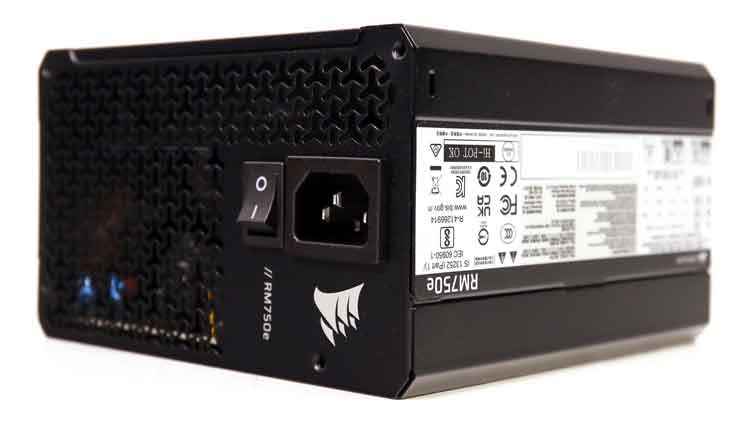
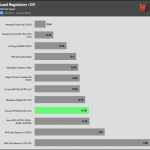
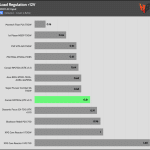
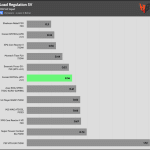
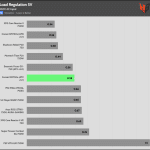
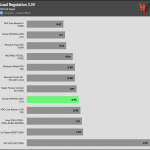
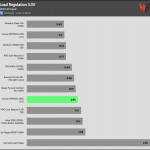
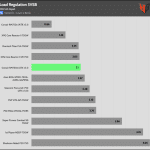
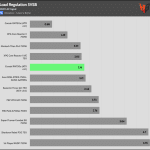
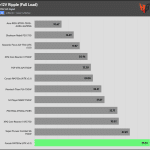
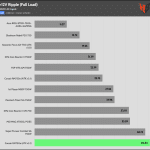
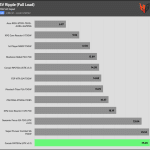
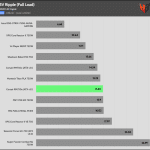
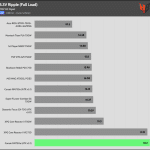
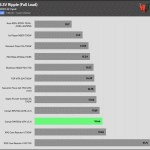
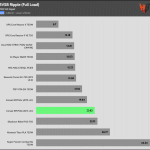
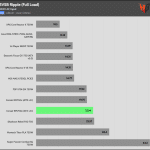
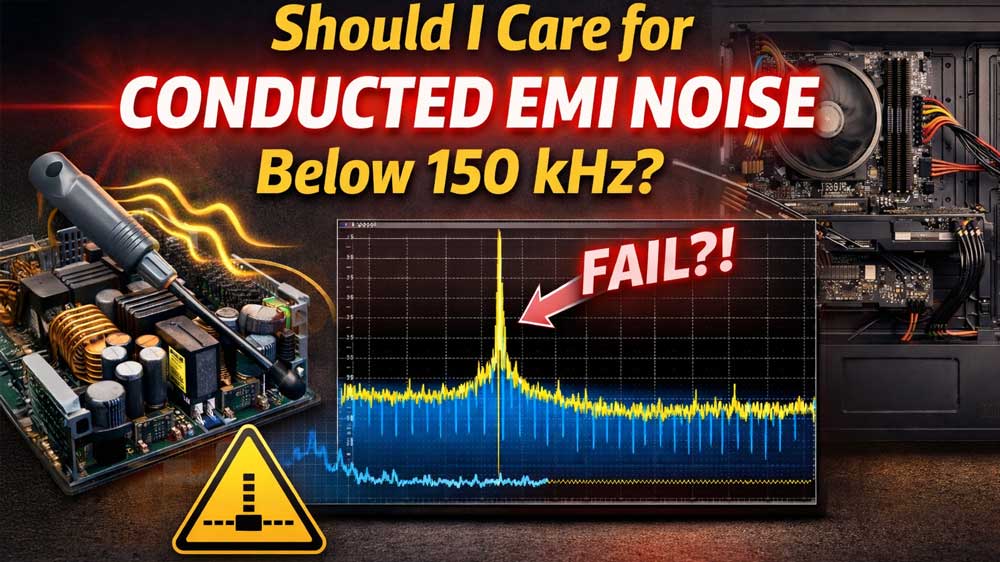
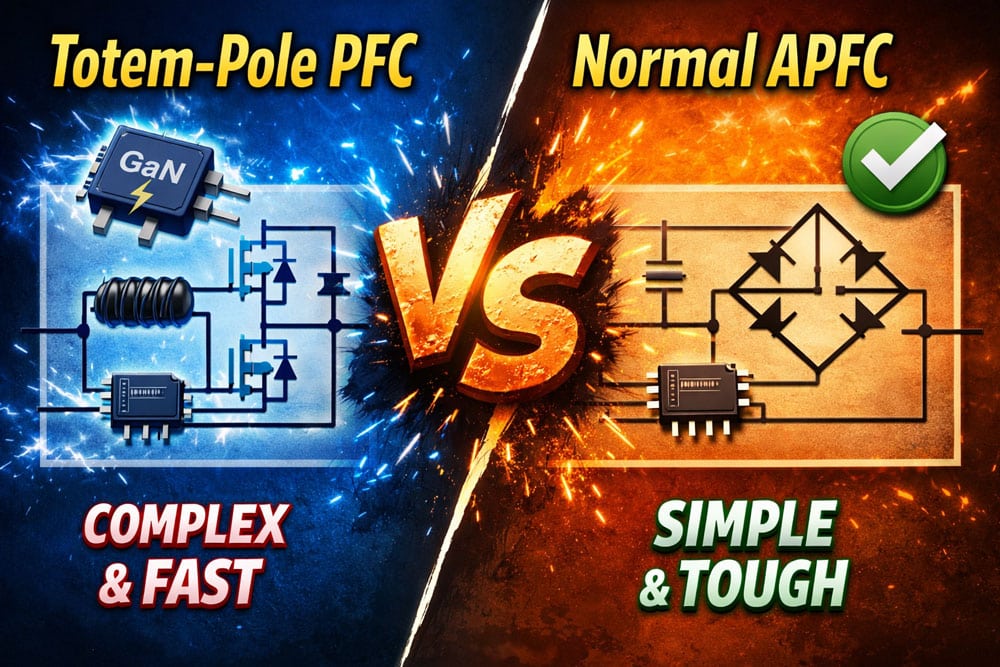
Hmm good to see I could have bought a much better PSU then this one for €100 which I think is way too much for a PSU of this type. In a hurry so much I thought this was the successor of the RM750X especially because it’s ATX 3.1 and that suddenly matters now that it’s coming out that PSU suppliers did not produce PSU’s that were up to specs. I say buy the cheaper ones because PSU manufacturers stopped caring about airflow in the PSU’s, something that was unthinkable years back.
Switching PSU’s need airflow/cooling when more then 150w needs to be supplied period. A spinning fan is the only thing that can supply airflow because convection cooling (like in amplifiers) is not possible in an ATX PSU. You could place the ATX PSU outside of the system and put a spinning fan on top of it. I do that. That’s the ONLY solution but that will not happen because folks adore especially the looks of the systems they’ve build and worship every part of it. Sleep well PC lovers knowing your overheated PSU will die while it has the potential to take every electronic part of the computer it feeds with it and more…..
I’ve seen switching PSU’s in copying machines die with a bang loud as loud as an illegal fire cracker. Faulty firmware overloaded the high capacity condensator to the point of explosion. Short them while bulging, and being overloaded, and the aluminum shell can punch a crack in the wall or take out an eye. That’s the amount of power they hold. Those PSU’s are six times the size of the ATX PSU board that feeds a PC. They have LARGE and heavy heat sinks for the power transistors. An office building that burns down because of them makes the news big time. It won’t happen because these PSU have been produced with safety in mind.
The PSU in your gaming PC on the other hand produces the same amount of power, have tiny, mini sized, heat sinks and no spinning or a too slow spinning fan so it overheats. Meanwhile the PSU manufacturers expect you to use their garbage for 10 years. That’s how much they care about your house. And that’s why it might be safer to buy a “moderate quality” (because the expensive ATX PSU’s have no better safety profile) and replace the dangerous thing within 5 years especially when the PSU stays on all the time. Those who do the latter should at least pull the power cord when leaving home.